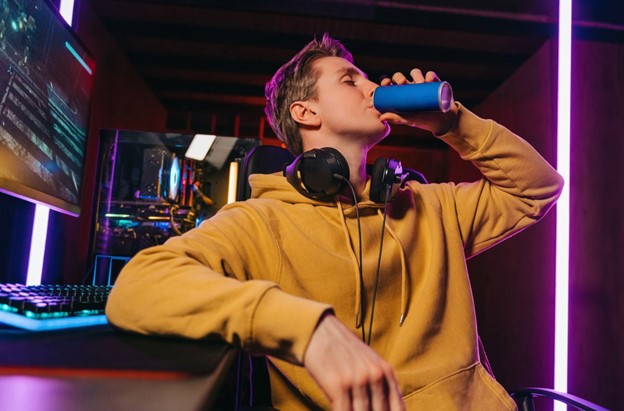Highlights
- Energy products are experiencing high growth.
- Consumers’ energy needs are expanding.
- Opportunities include energy +, natural energy, and optimizing energy products.
- Different energy ingredients address different needs.

Consumers are looking to improve their energy, but do they want a quick boost or sustained energy? A beverage or a bar? Here, we define the needs and opportunities in the evolving consumer energy landscape.
Energy needs have shifted far beyond pre-workout, with more occasions and an ever-broadening audience. In this evolving energy landscape, consumers are seeking the right type of energy at the right time—and there is no one-size-fits-all solution.
Energy/alertness is now the top health claim in product launches in North America, while energy drinks make up the largest share of the functional beverage market (with double digit growth year over year). Also growing are sales in performance/nutrition bars, which cater more toward sustained energy compared to the quick burst provided by energy drinks.
Consumers’ growing interest in natural and functional ingredients is reshaping the energy products category. At the same time, we see consumers taking steps to enhance their mental wellness and optimize their energy levels through the day, hinting at new opportunities in energy products.
Watch our on-demand webinar for a deep dive into the evolving consumer energy landscape.

Our recent Health and Wellness Usage & Attitude Study of 2,600 US and UK consumers aged 18-75 reveals that energy needs are multidimensional, with consumers taking both reactive and proactive approaches to energy.
Consider that everyone has a daily energy baseline. When consumers fall below it, their approach to energy becomes reactive. Then, they may be looking for a kick start or to refuel after exercising, for example. However, some are taking a proactive approach, seeking either sustained energy or a quick burst of energy to perform (physically and/or mentally), whether for work, fitness, or even gaming.
The study results indicate the three main need states consumers have around energy management are:
“When I need a quick energy fix to get over a dip in my energy levels.” and “Get me back on track to perform my best.”
“When I need something to fill me up enough to get through to my next meal–not too much–just something easy to bridge the gap.”
“When I need something to give me sustained lasting energy and also contribute positively to my health.” and “Nutrients to keep me at the top of my game.”
| Energy Need | % of occasions addressed with beverages | % of occasions addressed with food |
|---|---|---|
| Quick burst | 80% | 20% |
| Gap fill | 11% | 89% |
| Sustained vitality | 47% | 53% |
Consumers seeking quick burst energy are far more likely to satisfy the need with beverages over food, while gap filling is typically addressed through food, usually a snack. For sustained vitality, consumers are reaching for foods and beverages almost equally.
Brian Choi of The Food Institute identifies five mega trends of the year strongly impacting the food and beverage industry: Food Tech, Personalization, Sustainability, Inflation, and Health & Wellness. Within the latter, he highlights an expansion of consumer energy needs.
Trending on social media is the idea of targeting 30 grams of protein per meal for steady energy and blood sugar levels. There has also been a resurgence in creatine, particularly among young males, to support ATP replenishment for energy during exercise.

Snacking is a tool many consumers are using to manage their energy levels. Per capita, consumers globally are snacking more, while the consumption of traditional meals is on the decline. In the US and UK, more than 50% of consumers report skipping meals, which is often being replaced with snacking.
Certain snacking dayparts are strongly tied to energy needs, including late morning snacking to energize and fuel, and afternoon snacking as a pick me up. Gen Z and Millennials are the demographics doing the most snacking.
Some of the biggest opportunities for innovation in the energy space right now are:
While energy drinks are thriving, energy drinks with desired functional benefits—like supporting brain health or mental focus—will stand out to consumers as better products that provide additional value.
With more consumers proactively managing their energy levels to maintain their daily energy, an energy product positioned for optimizing daily energy provides the more targeted approach necessary to reach these consumers (for whom a quick burst energy drink is not the best fit).
Consumers are interested in natural and healthier energy products. For quick burst and sustained vitality beverages, this means a natural caffeine source and low sugar. For sustained vitality snacks, high protein is also important.

We are already seeing energy products adapting to these new needs and preferences. Best seller Ghost Energy Drink, which caters to the Gen Z demographic, is sugar-free and contains natural caffeine from coffee beans, plus vitamins and nootropic botanicals, giving it a reputation as a healthier energy drink.
Alani Nu is a women-focused sports nutrition brand, whose energy drink sales are growing fast. Like Ghost’s, Alani Nu’s energy drinks are free of sugar and flavor-forward, with vitamins and nootropics but with a very different look and marketing approach.
Glanbia Nutritionals offers energy-focused ingredient solutions to address this evolving consumer energy landscape. For a quick burst product, choose an energy-supporting bioactive like CreaBev® and combine it with a vitamin premix and our NutraShield® Triple Layer Caffeine.
For a beverage or bar positioned for sustained vitality, choose from our high-quality functional protein ingredients and add a vitamin-mineral premix for optimum nutritional support plus bioactives such as KSM-66® Ashwagandha or CapsiAtra®. From ideation to co-development, we are your ingredient partner every step of the way.
Energize your next innovation with insights from the experts. Contact us today to explore our energy solutions tailored to meet the demands of today's consumer.